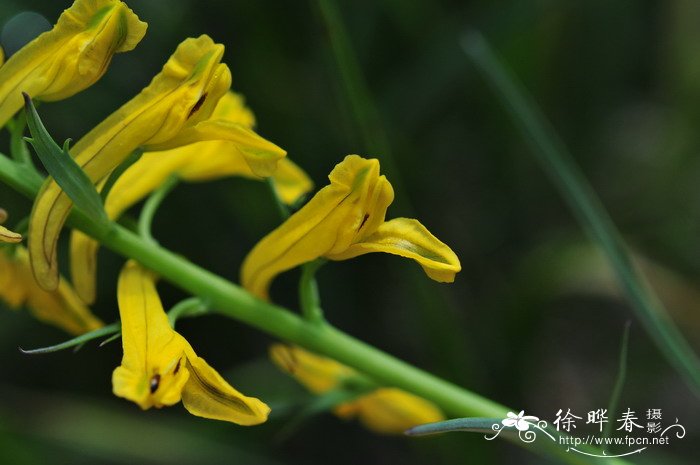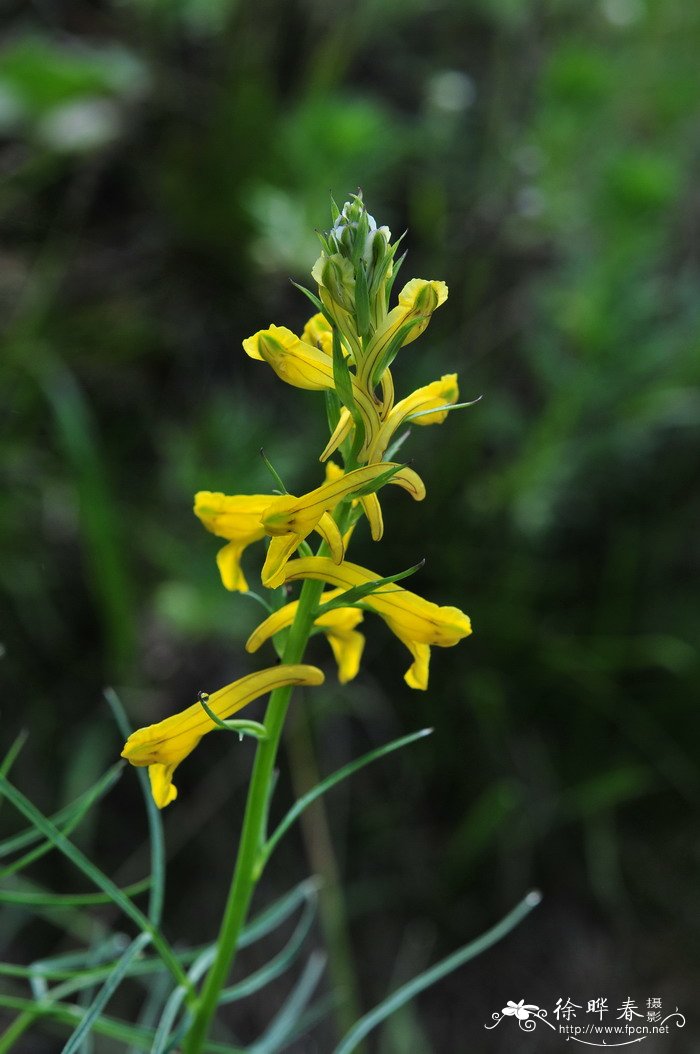条裂黄堇Corydalis linarioides
中文名(Chinese Name):条裂黄堇
学名(Scientific Name):Corydalis linarioides Maxim.
英文名(English Common Name):
别名(Chinese Common Name):铜棒锤、铜锤紫堇
异名(Synonym):Corydalis schlechteriana Fedde Capnoides linariodes Kuntze
科属(Family & Genus):罂粟科(Papaveraceae)紫堇属
形态特征(Description):直立草本,高25-50厘米。须根多数成簇,纺锤状肉质增粗,长达6厘米,黄色,味苦,具柄。茎2-5条,通常不分枝,有时具1-3分枝,上部具叶,下部裸露,基部变线形。基生叶少数,叶柄长达14厘米,基部变线形,叶片轮廓近圆形,长约4厘米,宽约3.5厘米,二回羽状分裂,第一回3全裂,顶生裂片具柄,5-7深裂,侧生裂片无柄,3裂,小裂片线形,背面具白粉,有时与茎生叶同形;茎生叶通常2-3枚,互生于茎上部,无柄,叶片一回奇数羽状全裂,全裂片3对,线形,长3-6厘米,宽2-3毫米,全缘,背面明显具3条纵脉。总状花序顶生,多花,花时密集,果时稀疏;苞片下部者羽状分裂,上部者狭披针状线形,最上部者线形。萼片鳞片状,边缘撕裂状,白色,微透明;花瓣黄色,上花瓣长1.6-1.9厘米,花瓣片舟状卵形,背部鸡冠状突起高约2毫米,自花瓣片先端稍后开始,延伸至距,距圆筒形,长0.9-1.1厘米,下花瓣倒卵形,长0.9-1厘米,背部鸡冠状突起较上花瓣的小,内花瓣提琴形,长7-8毫米,爪与花瓣片近等长;雄蕊束长6-7毫米,花药小,长圆形,花丝披针形,蜜腺体贯穿距的1/2;子房狭椭圆状线形,长4-5毫米,花柱长2-3毫米,先端弯曲,柱头双卵形,上端具2乳突。蒴果长圆形,长约1.2厘米,粗(1.5-)2毫米,成熟时自果梗基部反折。种子5-6枚,排成1列,近圆形,直径约1.5毫米,黑色,具光泽。花果期6-9月。
分布(Distribution):产陕西、宁夏、甘肃、青海、四川、西藏,生于海拔2100-4700米的林下、林缘、灌丛下、草坡或石缝中。
用途(Use):分布较广,因此变异也较大。块根具有药用价值,为太白山名药及青海藏药。
引自中国植物志英文版:FOC Vol. 7 Page 367, 368, 372
Corydalis linarioides Maximowicz, Bull. Acad. Imp. Sci. Saint-Pétersbourg, sér. 3. 24: 27. 1878.
条裂黄堇 tiao lie huang jin | Papaveraceae | Corydalis
?Corydalis linarioides var. fissibracteata Fedde; ?C. schlechteriana Fedde.
Herbs, perennial, 10-50 cm tall, glabrous or sparsely papillose at base of stem and sometimes abaxially on leaf; stems and petioles of radical leaves attenuate to filiform underground base. Storage roots few to several, spindle-shaped, 1-2 cm, narrowed into short or indistinct stalk (more distinct on young tubers). Stems 1-5, usually simple, rarely with 1 or 2 branches, with 2 or 3 leaves in upper 1/2. Radical leaves few; petiole to 14 cm; blade 2-4 × 2-5 cm, pinnate; leaflets cut to base into 2 or 3 linear to oblong lobes. Cauline leaves sessile; blade pinnate; pinnae 2-4 pairs, linear, 2-5 cm × 1-5 mm, entire. Raceme 6-20-flowered, dense, elongating in fruit; bracts lanceolate, entire or lower and middle bracts deeply pectinate-dentate to palmatifid, equaling pedicels. Pedicel 5-10 mm in flower, 10-15 mm and reflexed in fruit. Sepals whitish, 0.3-1 × 0.3-2 mm, finely and sharply dentate. Petals yellow, usually with distinct darker veins, apex usually orange, dorsal crest of inner petals often with small brown mark; upper petal 16-23 mm, subacute to subobtuse, abaxial crest 1-2 mm wide, from apex extended to spur, sometimes not reaching apex; spur straight or slightly downcurved at apex, cylindric, 8-15 mm; nectary ca. 1/2 as long as spur; lower petal obovate, 9-11 mm, abaxial crest smaller than that of upper petal; inner petals 7-9 mm. Stigma square; simple marginal papillae: median 2 distinct, lateral broad and indistinct; geminate papillae lateral (submarginal) and terminating well-developed basal lobes. Capsule narrowly oblong, 10-14 × 1.5-2 mm, smooth or sometimes with thin papillose lines, 3-8-seeded. Seeds 1-ranked, ca. 1.5 mm, smooth, with rather large elaiosomes. Fl. and fr. Jun-Sep.
● ?Forests, forest margins, shrubs, meadows, alpine pastures; (2100-)3200-4500 m. Gansu, Ningxia (Guyuan), Qinghai, Shaanxi, Shanxi, Sichuan, Xizang.
As here circumscribed, this taxon is probably heterogeneous. At least the following two forms can be recognized, but more research is needed to establish their status. The capsule and seed characters in the above description refer to Type B.
Type A. Stem robust, 10-25 cm, simple, glabrous; leaves stiff, adaxially dark glossy green, abaxially frequently with coarse 1-celled hairs on veins, leaflets 1-2 mm wide; lower and middle bracts pectinate-dentate with long narrow teeth; spur 10-15 mm. Open areas. This corresponds to Corydalis linarioides var. fissibracteata Fedde, p.p., and is similar to C. eugeniae in general appearance.
Type B. Stem slender, 20-50 cm, simple or rarely branched, glabrous or sometimes papillose-hairy at base; leaves soft, slightly glaucous, glabrous, leaflets 1-5 mm wide; bracts lanceolate, entire; spur 8-11 mm. More shaded places, e.g., in shrubs. This possibly corresponds to the type of Corydalis linarioides.
The complex comprising Corydalis linarioides, C. eugeniae, C. atuntsuensis, and C. mayae is far from satisfactorily elucidated, and the variation is reticulate. We have here taken storage root form as a primary discriminant: a) oblong with distinct thin long branched stalks (C. eugeniae); b) short fusiform with indistinct or short thick stalks (C. linarioides); c) long narrowly fusiform, gradually attenuate to base (C. atuntsuensis); d) similar, but stalks narrower (C. mayae).


 (责任编辑:徐晔春)
(责任编辑:徐晔春)
学名(Scientific Name):Corydalis linarioides Maxim.
英文名(English Common Name):
别名(Chinese Common Name):铜棒锤、铜锤紫堇
异名(Synonym):Corydalis schlechteriana Fedde Capnoides linariodes Kuntze
科属(Family & Genus):罂粟科(Papaveraceae)紫堇属
形态特征(Description):直立草本,高25-50厘米。须根多数成簇,纺锤状肉质增粗,长达6厘米,黄色,味苦,具柄。茎2-5条,通常不分枝,有时具1-3分枝,上部具叶,下部裸露,基部变线形。基生叶少数,叶柄长达14厘米,基部变线形,叶片轮廓近圆形,长约4厘米,宽约3.5厘米,二回羽状分裂,第一回3全裂,顶生裂片具柄,5-7深裂,侧生裂片无柄,3裂,小裂片线形,背面具白粉,有时与茎生叶同形;茎生叶通常2-3枚,互生于茎上部,无柄,叶片一回奇数羽状全裂,全裂片3对,线形,长3-6厘米,宽2-3毫米,全缘,背面明显具3条纵脉。总状花序顶生,多花,花时密集,果时稀疏;苞片下部者羽状分裂,上部者狭披针状线形,最上部者线形。萼片鳞片状,边缘撕裂状,白色,微透明;花瓣黄色,上花瓣长1.6-1.9厘米,花瓣片舟状卵形,背部鸡冠状突起高约2毫米,自花瓣片先端稍后开始,延伸至距,距圆筒形,长0.9-1.1厘米,下花瓣倒卵形,长0.9-1厘米,背部鸡冠状突起较上花瓣的小,内花瓣提琴形,长7-8毫米,爪与花瓣片近等长;雄蕊束长6-7毫米,花药小,长圆形,花丝披针形,蜜腺体贯穿距的1/2;子房狭椭圆状线形,长4-5毫米,花柱长2-3毫米,先端弯曲,柱头双卵形,上端具2乳突。蒴果长圆形,长约1.2厘米,粗(1.5-)2毫米,成熟时自果梗基部反折。种子5-6枚,排成1列,近圆形,直径约1.5毫米,黑色,具光泽。花果期6-9月。
分布(Distribution):产陕西、宁夏、甘肃、青海、四川、西藏,生于海拔2100-4700米的林下、林缘、灌丛下、草坡或石缝中。
用途(Use):分布较广,因此变异也较大。块根具有药用价值,为太白山名药及青海藏药。
引自中国植物志英文版:FOC Vol. 7 Page 367, 368, 372
Corydalis linarioides Maximowicz, Bull. Acad. Imp. Sci. Saint-Pétersbourg, sér. 3. 24: 27. 1878.
条裂黄堇 tiao lie huang jin | Papaveraceae | Corydalis
?Corydalis linarioides var. fissibracteata Fedde; ?C. schlechteriana Fedde.
Herbs, perennial, 10-50 cm tall, glabrous or sparsely papillose at base of stem and sometimes abaxially on leaf; stems and petioles of radical leaves attenuate to filiform underground base. Storage roots few to several, spindle-shaped, 1-2 cm, narrowed into short or indistinct stalk (more distinct on young tubers). Stems 1-5, usually simple, rarely with 1 or 2 branches, with 2 or 3 leaves in upper 1/2. Radical leaves few; petiole to 14 cm; blade 2-4 × 2-5 cm, pinnate; leaflets cut to base into 2 or 3 linear to oblong lobes. Cauline leaves sessile; blade pinnate; pinnae 2-4 pairs, linear, 2-5 cm × 1-5 mm, entire. Raceme 6-20-flowered, dense, elongating in fruit; bracts lanceolate, entire or lower and middle bracts deeply pectinate-dentate to palmatifid, equaling pedicels. Pedicel 5-10 mm in flower, 10-15 mm and reflexed in fruit. Sepals whitish, 0.3-1 × 0.3-2 mm, finely and sharply dentate. Petals yellow, usually with distinct darker veins, apex usually orange, dorsal crest of inner petals often with small brown mark; upper petal 16-23 mm, subacute to subobtuse, abaxial crest 1-2 mm wide, from apex extended to spur, sometimes not reaching apex; spur straight or slightly downcurved at apex, cylindric, 8-15 mm; nectary ca. 1/2 as long as spur; lower petal obovate, 9-11 mm, abaxial crest smaller than that of upper petal; inner petals 7-9 mm. Stigma square; simple marginal papillae: median 2 distinct, lateral broad and indistinct; geminate papillae lateral (submarginal) and terminating well-developed basal lobes. Capsule narrowly oblong, 10-14 × 1.5-2 mm, smooth or sometimes with thin papillose lines, 3-8-seeded. Seeds 1-ranked, ca. 1.5 mm, smooth, with rather large elaiosomes. Fl. and fr. Jun-Sep.
● ?Forests, forest margins, shrubs, meadows, alpine pastures; (2100-)3200-4500 m. Gansu, Ningxia (Guyuan), Qinghai, Shaanxi, Shanxi, Sichuan, Xizang.
As here circumscribed, this taxon is probably heterogeneous. At least the following two forms can be recognized, but more research is needed to establish their status. The capsule and seed characters in the above description refer to Type B.
Type A. Stem robust, 10-25 cm, simple, glabrous; leaves stiff, adaxially dark glossy green, abaxially frequently with coarse 1-celled hairs on veins, leaflets 1-2 mm wide; lower and middle bracts pectinate-dentate with long narrow teeth; spur 10-15 mm. Open areas. This corresponds to Corydalis linarioides var. fissibracteata Fedde, p.p., and is similar to C. eugeniae in general appearance.
Type B. Stem slender, 20-50 cm, simple or rarely branched, glabrous or sometimes papillose-hairy at base; leaves soft, slightly glaucous, glabrous, leaflets 1-5 mm wide; bracts lanceolate, entire; spur 8-11 mm. More shaded places, e.g., in shrubs. This possibly corresponds to the type of Corydalis linarioides.
The complex comprising Corydalis linarioides, C. eugeniae, C. atuntsuensis, and C. mayae is far from satisfactorily elucidated, and the variation is reticulate. We have here taken storage root form as a primary discriminant: a) oblong with distinct thin long branched stalks (C. eugeniae); b) short fusiform with indistinct or short thick stalks (C. linarioides); c) long narrowly fusiform, gradually attenuate to base (C. atuntsuensis); d) similar, but stalks narrower (C. mayae).
踩一下[0]

顶一下[0]